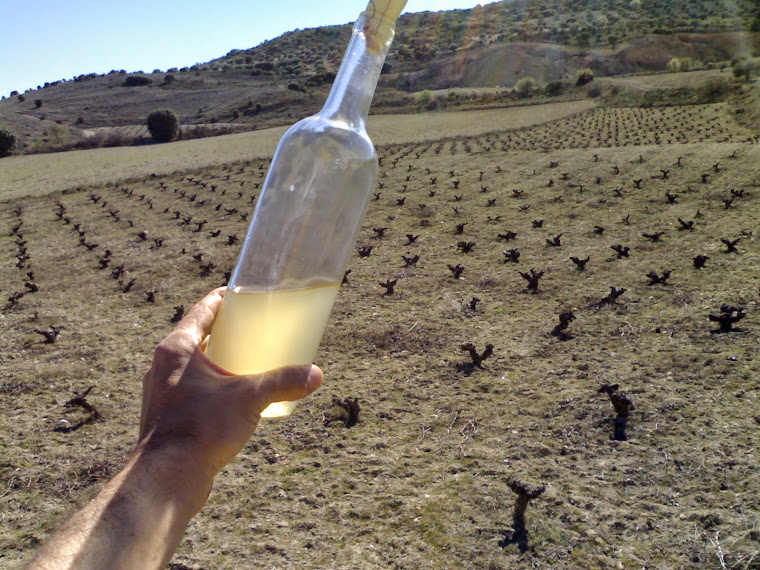Vineyard Work in Sierra de Gredos
(This is a post which I wrote way back in March 2020 and which I just found in my Drafts folder!)
Another year, another post!
I'm very disappointed that I haven't been able to post more often. I'm either just too lazy, too busy or too tired! But I shall make another effort this year and see if I can do better than once a year!
(Aside: this is the third week of lockdown in Spain due to the Coronavirus pandemic. However, as a grapegrower and winemaker, I am considered as part of the agriculture and food sector, hence "essential services" and so am allowed to travel to go to work.)
So, during the month of February I was focussing on a vineyard to the exclusion of almost everything else. It's a wonderful vineyard, in the middle of a pine forest and surrounded by rock roses and pinetrees, off the beaten track, and so very peaceful and relaxing.
There are many problems with this vineyard, the most serious of which is the lack of rain, and a few vines died this year. But there's nothing I can do about that.
 |
| Panoramic view of the bottom of the vineyard |
Another problem is that wild deer have somehow been getting in and eating the shoots/leaves/grapes. So I've been checking the perimeter fence and have been fixing the weak points.
One weak point is between the lowest part of the fence and the ground. The sneaky beasts somehow manage to wriggle their way in through these tiny gaps! So I'm going round the whole perimiter and blocking all the gaps, no matter how small. Using rocks and branches and clippings.
The vineyard is surrounded by pinetrees and rock roses. Rock roses are hardy and invasive. They smell nice and look nice, ...but they're invasive! If you don't keep an eye on them constantly, they'll just take over your vineyard!
 |
| In the foreground: Rock roses that I've cut back making the fence visible In the background: Rock roses growing through the fence |
Another problem with the deer is that not only can they sneak in under the fence, but they can also leap over it! So, when I finish blocking the gaps, I'll go round the perimeter again, but this time looking for any low points. I will then raise the height using poles (tied to the existing posts) and string or wire, and possibly some old CD's.
I found the poles in the forest beside the vineyard:
 |
| Pine forest seen through the fence |
 |
| Pine forest seen from the pine forest |
I didn't actually have to chop any trees down! There were lots of fallen trees and branches lying around already. I just had to saw them into lenghths and drag them up to the vineyard:
Then I tied them with wire to the existing low posts, and strung up some bright tape:
Apart from all of that, I also gave the vines some manure this year. This involved, first of all, digging up around each vine. This is a really fun activity and I recommend you come out to El Tiemblo, in the Sierra de Gredos, and lend a hand next year in another vineyard :)
After digging up arround the vines, we shovelled in some manure, using wheelbarrows and shovels:
 |
| Shovelling shit! |
 |
| Shovelled shit! |
Apart from digging a hole/trench beside each vine for the manure, we've also hoed up a circle of grass around the vine, to help retain any rainwater that may fall this spring. This vineyard is very steep, so any rain that falls tends to run off as opposed to being absorbed by the earth, due to the grass.
This vineyard is Garnacha, about 50 years old, and I use it to make a classic red wine, aged in barrel. I used to get about 4 or 5 barrels (1500 bottles) but last year only 1 barrel (300 bottles) due to the drought.
I call it "El Castañar" because the vineyard is on the way to the famous El Castañar de El Tiemblo, chestnut forest of El Tiemblo, which is about 5 km further up the road.
And lastly, I had to clear up a slight mess caused by a pine tree falling into the vineyard and destroyimg a small part of the fence:
All that was in February.
In March I was mainly bottling up (including some pet nats), but I'll write about that in another post soon. Hopefully!
I hope you are all bearing up well during the lockdown and confinement. If you need more wine these days, I'd be very happy to ship some to you, or have my distributor ship it, depending on where you live!






































